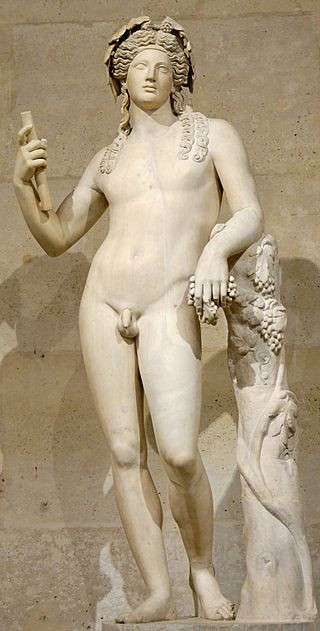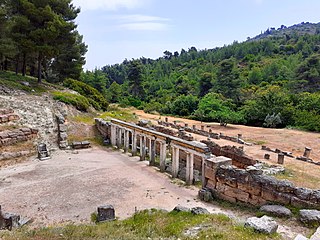Related Research Articles

In ancient Greek religion, Hera is the goddess of marriage, women, and family, and the protector of women during childbirth. In Greek mythology, she is queen of the twelve Olympians and Mount Olympus, sister and wife of Zeus, and daughter of the Titans Cronus and Rhea. One of her defining characteristics in myth is her jealous and vengeful nature in dealing with any who offended her, especially Zeus's numerous adulterous lovers and illegitimate offspring.

In ancient Greek religion and myth, Dionysus is the god of wine-making, orchards and fruit, vegetation, fertility, festivity, insanity, ritual madness, religious ecstasy, and theatre. He was also known as Bacchus by the Greeks for a frenzy he is said to induce called baccheia. As Dionysus Eleutherius, his wine, music, and ecstatic dance free his followers from self-conscious fear and care, and subvert the oppressive restraints of the powerful. His thyrsus, a fennel-stem sceptre, sometimes wound with ivy and dripping with honey, is both a beneficent wand and a weapon used to destroy those who oppose his cult and the freedoms he represents. Those who partake of his mysteries are believed to become possessed and empowered by the god himself.

Semele, or Thyone in Greek mythology, was the youngest daughter of Cadmus and Harmonia, and the mother of Dionysus by Zeus in one of his many origin myths.

In Greek mythology, maenads were the female followers of Dionysus and the most significant members of the thiasus, the god's retinue. Their name, which comes from μαίνομαι, literally translates as 'raving ones'. Maenads were known as Bassarids, Bacchae, or Bacchantes in Roman mythology after the penchant of the equivalent Roman god, Bacchus, to wear a bassaris or fox skin.

Eileithyia or Ilithyia was the Greek goddess of childbirth and midwifery, and the daughter of Zeus and Hera. In the cave of Amnisos (Crete) she was related with the annual birth of the divine child, and her cult is connected with Enesidaon, who was the chthonic aspect of the god Poseidon. It is possible that her cult is related with the cult of Eleusis. In his Seventh Nemean Ode, Pindar refers to her as the maid to or seated beside the Moirai (Fates) and responsible for the creation of offspring. Her son was Sosipolis, who was worshiped at Elis.
In ancient Greek religion and mythology, Iacchus was a minor deity, of some cultic importance, particularly at Athens and Eleusis in connection with the Eleusinian mysteries, but without any significant mythology. He perhaps originated as the personification of the ritual exclamation Iacche! cried out during the Eleusinian procession from Athens to Eleusis. He was often identified with Dionysus, perhaps because of the resemblance of the names Iacchus and Bacchus, another name for Dionysus. By various accounts he was a son of Demeter, or a son of Persephone, identical with Dionysus Zagreus, or a son of Dionysus.

In Greek mythology, the Cabeiri or Cabiri, also transliterated Kabeiri or Kabiri, were a group of enigmatic chthonic deities. They were worshipped in a mystery cult closely associated with that of Hephaestus, centered in the north Aegean Islands of Lemnos and possibly Samothrace—at the Samothrace temple complex—and at Thebes. In their distant origins the Cabeiri and the Samothracian gods may include pre-Greek elements, or other non-Greek elements, such as Thracian, Tyrrhenian, Pelasgian, Phrygian or Hittite. The Lemnian cult was always local to Lemnos, but the Samothracian mystery cult spread rapidly throughout the Greek world during the Hellenistic period, eventually initiating Romans.

Sabazios is a deity originating in Asia Minor. He is the horseman and sky father god of the Phrygians and Thracians.

Thespiae was an ancient Greek city (polis) in Boeotia. It stood on level ground commanded by the low range of hills which run eastward from the foot of Mount Helicon to Thebes, near modern Thespies.

Eleutherae is a city in the northern part of Attica, bordering the territory of Boeotia. One of the best preserved fortresses of Ancient Greece stands now on the spot of an Ancient Eleutherae castle, dated between 370 and 360 BC, with walls of very fine masonry that average 2.6m thick. A circuit of wall 860 m contained towers, 6 of them still standing along the northern edge of the site, preserved to the height of 4 to 6 m. The foundations of more towers are present. Although not as well preserved, the line of the remainder of the fortification circuit is clear, as is the location of the one large, double gate (western) and one small (south-eastern) gate. There are two small sally-ports located on the north side. The fortified area is irregular and c. 113 by 290m in extent.

Orchomenus, the setting for many early Greek myths, is best known today as a rich archaeological site in Boeotia, Greece, that was inhabited from the Neolithic through the Hellenistic periods. It is often referred to as "Minyan Orchomenus", to distinguish it from a later city of the same name in Arcadia.
Amykles is a village in Laconia, southern Greece. It lies in the plain by the Eurotas river, 6 km south of Sparta, east of the Taygetus mountains, along the Greek National Road 39 from Sparta to Gytheio. It was named after the ancient town Amyclae, the ruins of which are situated 2 km northeast of the village.

The Thracian religion comprised the mythology, ritual practices and beliefs of the Thracians, a collection of closely related ancient Indo-European peoples who inhabited eastern and southeastern Europe and northwestern Anatolia throughout antiquity and who included the Thracians proper, the Getae, the Dacians, and the Bithynians.
In Greek mythology, Polydorus or Polydoros was a king of Thebes.

For the Apollo Temple in the Grand Canyon, see Apollo Temple.

The Amphiareion of Oropos, situated in the hills 6 km southeast of the fortified port of Oropos, was a sanctuary dedicated in the late 5th century BCE to the hero Amphiaraos, where pilgrims went to seek oracular responses and healing. It became particularly successful during the 4th century BCE, to judge from the intensive building at the site. The hero Amphiaraos was a descendant of the seer Melampos and initially refused to participate in the attack on Thebes because he could foresee that it would be a disaster. In some versions of the myth, the earth opens and swallows the chariot of Amphiaraos, transforming him into a chthonic hero. Today the site is found east of the modern town Markopoulo Oropou in the Oropos municipality of Attica, Greece.

In Greek mythology, Orpheus was a Thracian bard, legendary musician and prophet. He was also a renowned poet and, according to the legend, travelled with Jason and the Argonauts in search of the Golden Fleece, and even descended into the underworld of Hades, to recover his lost wife Eurydice.
Anthedon (Ἀνθηδών) was a town in Boeotia, Ancient Greece, located on the coast of the Gulf of Euboea, about 15 kilometres (9.3 mi) west of Chalcis, at the foot of Mount Messapius. It was member of the Amphictyonic League, and served as port for Thebes. In ancient times, it was believed to have had one of the mythical characters named Anthedon as its eponym.

Ancient Greek literary sources claim that among the many deities worshipped by a typical Greek city-state, one consistently held unique status as founding patron and protector of the polis, its citizens, governance and territories, as evidenced by the city's founding myth, and by high levels of investment in the deity's temple and civic cult. The temple of the deity involved was usually founded on the highest ground (acropolis) within the city walls, or elsewhere within the central public assembly space, the agora. Conversely, a city's possession of a patron deity was thought to be a mark of the city's status as polis.
In ancient Greek religion and mythology, Melia, a daughter of the Titan Oceanus, was the consort of Apollo, and the mother, by Apollo, of the Theban hero and prophet Tenerus. She was also the mother of Ismenus, god of the Theban river of the same name. Melia was an important cult figure at Thebes. She was worshipped at the Ismenion, the Temple of Apollo at Thebes, and was associated with a nearby spring.